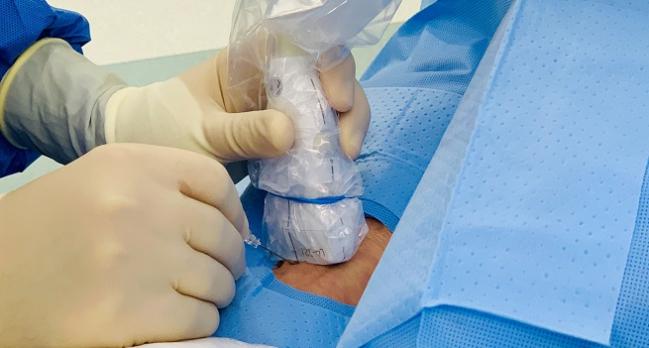Transradial Access Still Beats Transfemoral for STEMI in Updated Meta-analysis
Even after inclusion of the neutral SAFARI-STEMI results, transradial carried lower mortality and bleeding risks.

STEMI patients undergoing primary PCI fare better when transradial versus transfemoral access is used, an updated meta-analysis shows, confirming the findings of previous pooled analyses.
Transradial access was associated with lower risks of all-cause mortality, major bleeding, and vascular complications, with no differences between groups in MI, stroke, or procedure duration, researchers report in the American Journal of Cardiology. Of the outcomes evaluated, only fluoroscopy duration favored the transfemoral approach.
“Transradial access is safe as well as efficacious in STEMI patients, and it’s actually reducing hard endpoints,” senior author Poonam Velagapudi, MD (University of Nebraska Medical Center, Omaha), told TCTMD. She pointed out that STEMI guidelines from the European Society of Cardiology contain a Class IA recommendation to use radial over femoral access if performed by an experienced radial operator, “and probably we should also do that here in the United States. That should be the primary access for STEMI patients based on so much data that we have now.”
Bleeding Drives Mortality
Prior trials comparing transradial and transfemoral access have not been powered to detect meaningful differences in hard outcomes like mortality, the researchers note, but previous meta-analyses—including one in JACC: Cardiovascular Interventions and one in the Canadian Journal of Cardiology—have shown that transradial access is associated with lower risks of all-cause mortality, major bleeding, and MACE. Since then, however, the SAFARI-STEMI trial failed to demonstrate differences in 30-day all-cause mortality and major bleeding based on access site.
[Radial] should be the primary access for STEMI patients based on so much data that we have now. Poonam Velagapudi
The updated meta-analysis by Velagapudi et al includes SAFARI-STEMI along with 16 prior RCTs, for a total pooled patient population of 12,018. Mean/median patient age ranged from 52 to 71 across trials, and about three-quarters of participants were men. Glycoprotein IIb/IIIa inhibitors were used in about half of all patients.
There were no differences between groups in MI (RR 0.96; 95% CI 0.75-1.24), stroke (RR 1.37; 95% CI 0.82-2.29), or procedure duration, although fluoroscopy time was shorter during transfemoral procedures.
The investigators calculated weighted bleeding rates of 2.2% and 3.8% in the transradial and transfemoral groups, respectively. That means, according to Velagapudi, that for every 1,000 patients treated through the wrist versus the groin, there would be at least 16 fewer bleeding events.
The researchers also showed that when the risk of major bleeding is held constant, there is no longer a difference in mortality between the two access approaches, which indicates that bleeding is driving mortality in the setting of STEMI.
US Adoption Lags Behind
Velagapudi pointed out that US operators have lagged behind their European counterparts when it comes to transradial adoption, with access obtained through the wrist in 40% to 50% of PCIs in the US and 70% to 90% of those in Europe. “The utilization of transradial access has been limited by the perception of higher procedural failure and longer procedural duration that can be detrimental, especially in STEMI patients where immediate reperfusion is essential,” she and her colleagues write in their paper. However, they add, those concerns are “based on confounded data from earlier observational studies derived from inexperienced operators.”
It would behoove the American interventional community to close the gap for primary PCI, which involves intensive use of antithrombotic and antiplatelet therapy that can lead to bleeding, Velagapudi indicated. “Reducing these bleeding issues may help increase the net ischemic benefit if you’re able to do a transradial access,” she said.
To convince more US operators to use the transradial approach, she said, “It’s really important that people recognize that radial access is better than femoral access in STEMI, and train the next generation so folks get adept at transradial access with their regular cases first and then they can jump into the STEMI cases. It’s really important to help people learn the technique and get better at the technique.”
There are some cases that would not necessarily be suitable for transradial access, Velagapudi said, pointing to patients presenting in cardiogenic shock. Most operators use the transfemoral approach in this scenario because of the need for mechanical circulatory support, she explained.
However, she and her colleagues write, “it is also worth noting that similar magnitude of benefit in terms of bleeding complications has been observed with transradial access even in [the] high-risk STEMI population (cardiogenic shock, hemodynamic instability, or failed antithrombotic therapy) enrolled in the RIFLE-STEACS (Radial Versus Femoral Randomized Investigation in ST-Elevation Acute Coronary Syndrome) trial. Similar results were later reproduced in real-world patient registries as well. Paradoxically, transradial access is less frequently utilized in such high-risk groups.”
They point out that there is a strong relationship between operator procedural volume and outcomes for transradial PCI. “To minimize the learning curve and enhance performance metrics, certain volume requirements have been previously laid down by [the] SCAI (Society for Cardiovascular Angiography and Interventions) transradial working group,” Velagapudi et al write, adding that gradually tackling more-complex cases and increasing use of hydrophilic transradial sheaths will “help facilitate the rapid dispersion of [a] radial-first strategy. Once transradial access . . . is mastered, and patients with high bleeding risk are selected, the benefits will likely be greatest.”
Photo Credit: Poonam Velagapudi
Todd Neale is the Associate News Editor for TCTMD and a Senior Medical Journalist. He got his start in journalism at …
Read Full BioSources
Jhand A, Atti V, Gwon Y, et al. Meta-analysis of transradial vs transfemoral access for percutaneous coronary intervention in patients with ST elevation myocardial infarction. Am J Cardiol. 2020;Epub ahead of print.
Disclosures
- Velagapudi reports no relevant conflicts of interest.


Comments